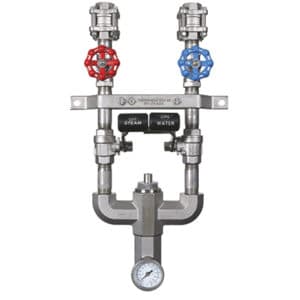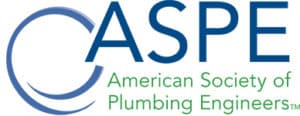Originally published in Industrial Safety & Hygiene News.
Safety showers and face/eyewash stations are critical pieces of equipment in any workplace where chemical spills are a potential threat. ThermOmegaTech®, a leader in self-actuating thermostatic technology, offers an innovative solution to the challenge of supplying safety fixtures with consistently tepid water on demand.
An industrial chemical manufacturer located in Ontario, Canada recently began a $2 billion expansion of their existing production facility. Due to the presence of potentially hazardous materials in chemical manufacturing, the installation of safety showers and face/eyewash stations was a plant necessity.
The company’s other sites have had success using ThermOmegaTech®’s Therm-O-Mix® Station for instantaneous tepid water delivery, therefore the Therm-O-Mix® Station was again selected for this expansion to promote overall conformity of safety equipment and procedures. ThermOmegaTech®’s TV/SC-A valve was also chosen to control the safety station enclosure’s ambient air temperature.
The Therm-O-Mix® Station utilizes only a facility’s existing steam and water supply to instantaneously deliver tepid water to emergency safety showers and face/eyewash stations. When an emergency fixture is activated, the resulting pressure drop on a diaphragm establishes flow and opens a steam control valve, which the station uses to heat cold water. The now hot water travels through an initial tempering valve that adds cold water and reduces the water temperature to about 100°F (37.7°C), then through a second mixing valve that adds more cold water and lowers the temperature to an OSHA-approved 80°F (26.6°C), before being delivered through the emergency fixtures.
The expansion project included a mix of classified and non-classified environments. Equipment in the classified section of the plant needed to be explosion-proof due to the sensitive nature of the chemicals produced on-site and by selecting the Therm-O-Mix®, the facility avoided the need for an expensive insulation process.
“Our Therm-O-Mix® Station operates completely mechanically,” Timothy Hartung, industrial product manager at ThermOmegaTech® commented. “It doesn’t require a source of electricity to operate, so it’s the ideal tepid water delivery product for refineries and factories with explosion proof environments.”
A necessary addition to any new or existing facility to comply with ANSI Z358.1, the Therm-O-Mix® Station has a small footprint, does not require insulated tanks or expensive recirculation systems, and is self-purging so there is no need for an elaborate drainage system.
The Therm-O-Mix® Station was mounted onto the outside of a polar cubicle and plumbed to deliver tepid water to the safety showers and face/eyewash station inside of the cubicle.
To maintain the temperature inside of the cubicle at a level where users would feel comfortable disrobing for proper safety shower operation, ThermOmegaTech®’s TV/SC-A valve was selected to control the flow of steam.
A thermostatic actuator on the end of the TV/SC-A valve located inside of the polar cubicle monitors and responds to the ambient temperature inside the cubicle. When the temperature falls to the valves set point, the TV/SC-A modulates open to allow steam to flow through a radiation element, which is traced inside of the cubicle to warm it up. Once the ambient temperature has risen, the valve modulates closed again to conserve steam.
“Installation of 26 integrated units is currently underway at the facility and will be completed by the end of 2019,” Hartung commented.
Compact and reliable, the Therm-O-Mix® tepid water delivery station is an essential fixture in any facility where chemicals are being handled to ensure both worker safety and guideline compliance.
Check out the full article at ISHN.com.
 Graduating from Villanova University with a Mechanical Engineering degree in 1990, Glenn Quinty is a highly trained and technical design engineer, with 30+ years of experience.
Graduating from Villanova University with a Mechanical Engineering degree in 1990, Glenn Quinty is a highly trained and technical design engineer, with 30+ years of experience.

